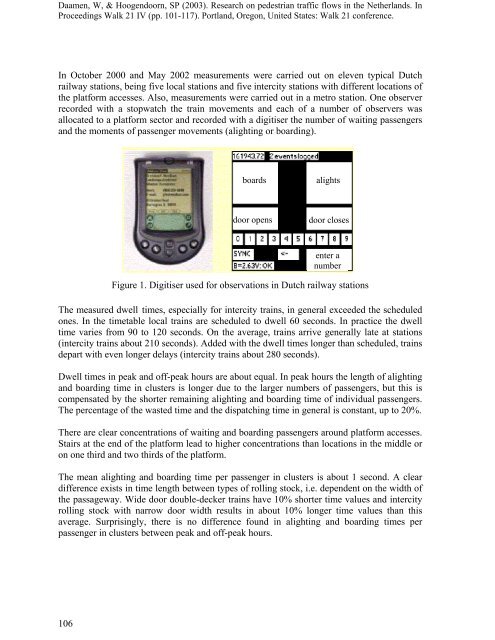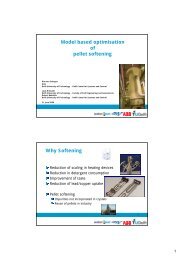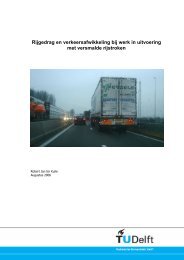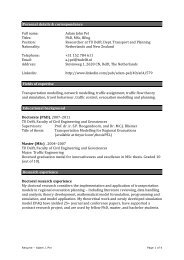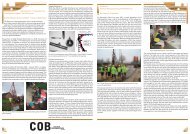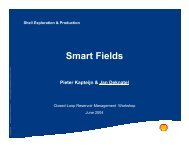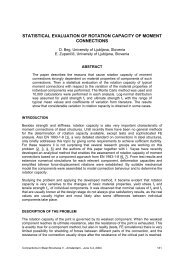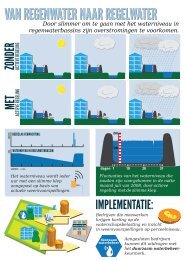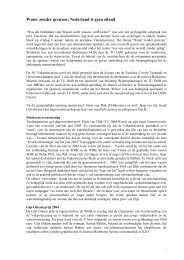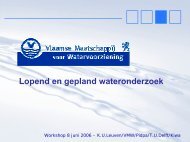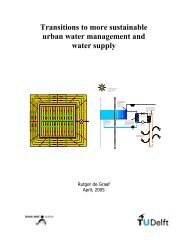Research on pedestrian traffic flow in the Netherlands - TU Delft
Research on pedestrian traffic flow in the Netherlands - TU Delft
Research on pedestrian traffic flow in the Netherlands - TU Delft
You also want an ePaper? Increase the reach of your titles
YUMPU automatically turns print PDFs into web optimized ePapers that Google loves.
Daamen, W, & Hoogendoorn, SP (2003). <str<strong>on</strong>g>Research</str<strong>on</strong>g> <strong>on</strong> <strong>pedestrian</strong> <strong>traffic</strong> <strong>flow</strong>s <strong>in</strong> <strong>the</strong> Ne<strong>the</strong>rlands. In<br />
Proceed<strong>in</strong>gs Walk 21 IV (pp. 101-117). Portland, Oreg<strong>on</strong>, United States: Walk 21 c<strong>on</strong>ference.<br />
In October 2000 and May 2002 measurements were carried out <strong>on</strong> eleven typical Dutch<br />
railway stati<strong>on</strong>s, be<strong>in</strong>g five local stati<strong>on</strong>s and five <strong>in</strong>tercity stati<strong>on</strong>s with different locati<strong>on</strong>s of<br />
<strong>the</strong> platform accesses. Also, measurements were carried out <strong>in</strong> a metro stati<strong>on</strong>. One observer<br />
recorded with a stopwatch <strong>the</strong> tra<strong>in</strong> movements and each of a number of observers was<br />
allocated to a platform sector and recorded with a digitiser <strong>the</strong> number of wait<strong>in</strong>g passengers<br />
and <strong>the</strong> moments of passenger movements (alight<strong>in</strong>g or board<strong>in</strong>g).<br />
boards<br />
alights<br />
door opens<br />
door closes<br />
enter a<br />
number<br />
Figure 1. Digitiser used for observati<strong>on</strong>s <strong>in</strong> Dutch railway stati<strong>on</strong>s<br />
The measured dwell times, especially for <strong>in</strong>tercity tra<strong>in</strong>s, <strong>in</strong> general exceeded <strong>the</strong> scheduled<br />
<strong>on</strong>es. In <strong>the</strong> timetable local tra<strong>in</strong>s are scheduled to dwell 60 sec<strong>on</strong>ds. In practice <strong>the</strong> dwell<br />
time varies from 90 to 120 sec<strong>on</strong>ds. On <strong>the</strong> average, tra<strong>in</strong>s arrive generally late at stati<strong>on</strong>s<br />
(<strong>in</strong>tercity tra<strong>in</strong>s about 210 sec<strong>on</strong>ds). Added with <strong>the</strong> dwell times l<strong>on</strong>ger than scheduled, tra<strong>in</strong>s<br />
depart with even l<strong>on</strong>ger delays (<strong>in</strong>tercity tra<strong>in</strong>s about 280 sec<strong>on</strong>ds).<br />
Dwell times <strong>in</strong> peak and off-peak hours are about equal. In peak hours <strong>the</strong> length of alight<strong>in</strong>g<br />
and board<strong>in</strong>g time <strong>in</strong> clusters is l<strong>on</strong>ger due to <strong>the</strong> larger numbers of passengers, but this is<br />
compensated by <strong>the</strong> shorter rema<strong>in</strong><strong>in</strong>g alight<strong>in</strong>g and board<strong>in</strong>g time of <strong>in</strong>dividual passengers.<br />
The percentage of <strong>the</strong> wasted time and <strong>the</strong> dispatch<strong>in</strong>g time <strong>in</strong> general is c<strong>on</strong>stant, up to 20%.<br />
There are clear c<strong>on</strong>centrati<strong>on</strong>s of wait<strong>in</strong>g and board<strong>in</strong>g passengers around platform accesses.<br />
Stairs at <strong>the</strong> end of <strong>the</strong> platform lead to higher c<strong>on</strong>centrati<strong>on</strong>s than locati<strong>on</strong>s <strong>in</strong> <strong>the</strong> middle or<br />
<strong>on</strong> <strong>on</strong>e third and two thirds of <strong>the</strong> platform.<br />
The mean alight<strong>in</strong>g and board<strong>in</strong>g time per passenger <strong>in</strong> clusters is about 1 sec<strong>on</strong>d. A clear<br />
difference exists <strong>in</strong> time length between types of roll<strong>in</strong>g stock, i.e. dependent <strong>on</strong> <strong>the</strong> width of<br />
<strong>the</strong> passageway. Wide door double-decker tra<strong>in</strong>s have 10% shorter time values and <strong>in</strong>tercity<br />
roll<strong>in</strong>g stock with narrow door width results <strong>in</strong> about 10% l<strong>on</strong>ger time values than this<br />
average. Surpris<strong>in</strong>gly, <strong>the</strong>re is no difference found <strong>in</strong> alight<strong>in</strong>g and board<strong>in</strong>g times per<br />
passenger <strong>in</strong> clusters between peak and off-peak hours.<br />
106


